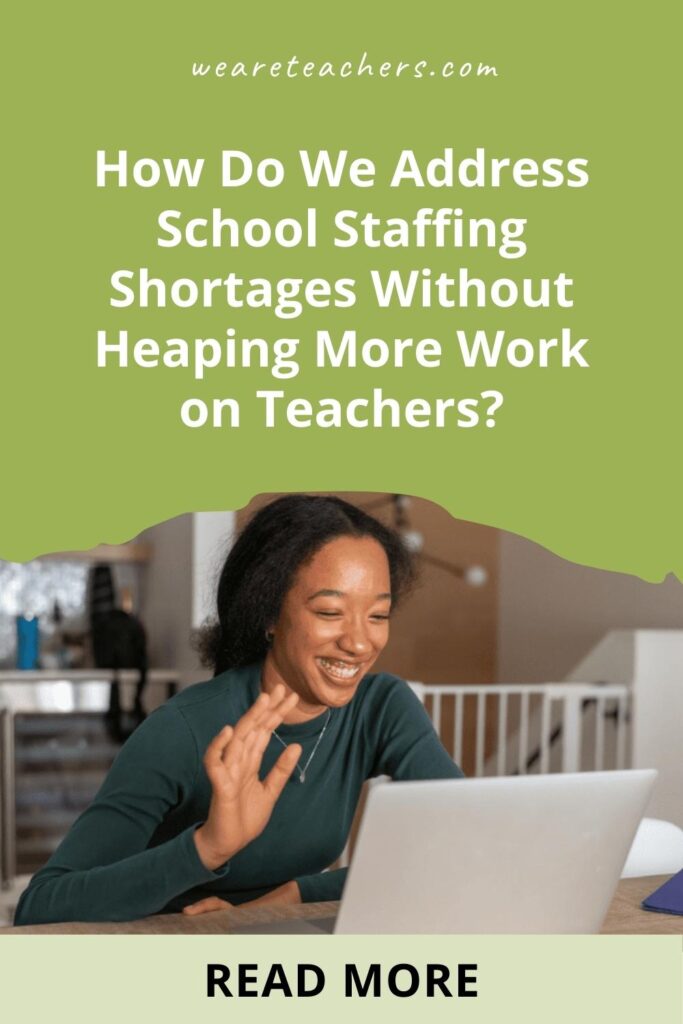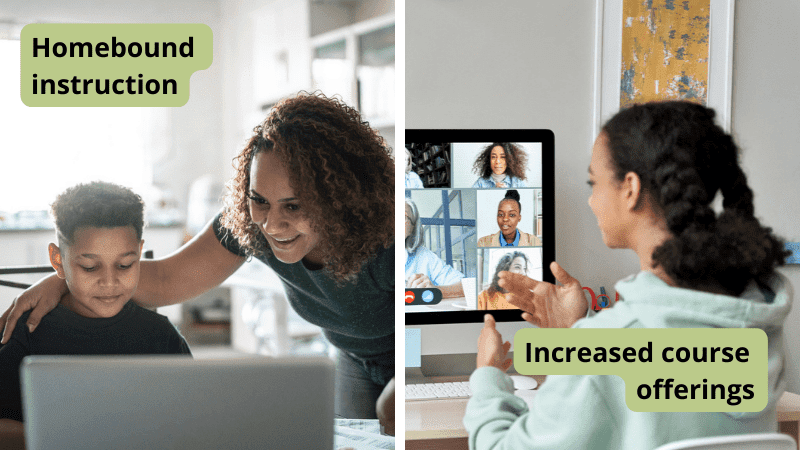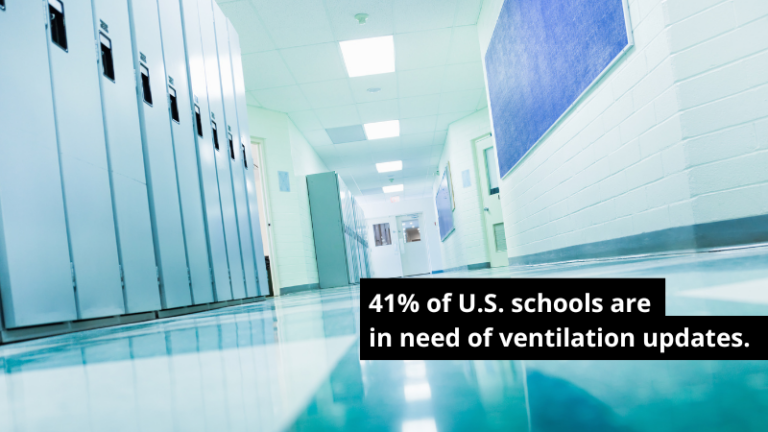A recent survey revealed that over half the public school principals who responded started this school year with staffing shortages. While schools struggle to fill the open positions, teachers are often the ones faced with picking up the slack. This is unsustainable. Teachers’ plates are already overflowing with their normal day-to-day tasks without adding the work of unfilled positions onto them. In light of this, many districts have begun partnering with online tutoring and virtual teaching companies. It turns out, there are some very effective virtual solutions for these in-person problems.
Problem: Meeting the varied needs of all the students when there aren’t enough in-person teachers

Teachers have always had to differentiate instruction and meet each of their students’ unique learning needs. Whether identified with an IEP or 504 plan or not, each student has specific ways they learn best and good teachers attempt to accommodate them in class. But a lack of support staff, special education teachers, and additional service providers means that classroom teachers are often left doing the jobs of three or more people.
Solution:
In a school that has access to both classroom and virtual teachers, differentiation becomes a much more achievable goal. The five students in the building who could be taking Mandarin II can do so. The school district can work with a virtual teacher, certified in Mandarin, who can meet with them online. Classroom teachers who see a group of students who need additional support in making inferences can schedule time with them to work with a virtual teacher. The virtual teacher can meet with students during free periods, study halls, or even before or after school study sessions. Having classroom and virtual teachers who can work together creates far more options for differentiation that works for students.
Problem: Homebound instruction falls solely on overworked classroom teachers

In my district, the guidance counselors were frequently emailing classroom teachers asking for homebound instruction volunteers. For a stipend, teachers were asked to teach a student at their home for several hours a week. Yes, you were getting paid. But you were also agreeing to give up more of your personal time to teach. Other times it is parents who ask if their child’s classroom teacher can meet before or after school for additional help. And while it’s always wonderful to have parents advocating for their children, the classroom teacher is the one who has to decide to “refuse to help their student” or give up more of their own time.
Solution:
Classroom teachers have a rigid daily schedule. Their only available times for additional duties like homebound instruction or tutoring are outside their workday. Virtual teachers, on the other hand, have far more flexibility. They can meet with students at a variety of times. Because of this, a district offering virtual instruction could have one virtual teacher who met with multiple homebound students throughout the day and still had time to offer tutoring sessions. By working together with the classroom teachers in the building or district, the virtual teacher could provide the instruction each student needed. The classroom teachers and virtual teacher would communicate about curriculum and materials, but would be able to share the responsibilities of instruction, review, and assessment.
Problem: Without proper staffing, discipline fails to be equitable and purposeful

We knew that the typical discipline model wasn’t working before COVID-19 closed school buildings. The ACLU reports that suspended students are far more likely to come in contact with the juvenile justice system. They are also three times more likely to be Black than white. In addition to the serious concerns about equity in discipline, there are also the day-to-day concerns. Districts are still legally required to provide suspended students with academic services while they’re out of school. Often, providing that work becomes the responsibility of the classroom teacher. We have to make time to provide materials and instruction for students who often won’t do it anyway. This places them even further behind their peers when they return to the classroom, increasing the likelihood that they’ll continue to act out behaviorally.
Solution:
Some online teaching companies have begun to address this problem by offering virtual suspension classes. Virtual teachers can ensure that suspended students are both meeting the requirements of their punishments and receiving instruction that will help them return to their classrooms better prepared. One superintendent explained how this method benefited the students by saying, “in addition to the academic piece … these are kids that would normally be home, and isolated … they’d be playing their Xbox, or they’re out in the community making poor decisions. Here, we’ve coupled this with an additional in-district program, but the instructional portion of their day is directed by the district; it’s in the district, it’s in school, and they feel like a part of something again. So it really helps reconnect them back to school to be productive and successful.”
Problem: Lack of staffing creates challenges supporting our English-language learners (ELLs)

Our ELL teachers do tremendous work helping students whose primary language isn’t English. Every day they work to ensure these students receive an education while simultaneously helping them fit in at a school where the cultures and spoken languages may differ greatly from their own. This is highly challenging work. And often, classroom teachers not trained to work with ELL students struggle to provide these students with the support they need. While trying to meet the needs of all the other students in their classrooms, teachers asked to do the same for a student who doesn’t speak the language is a huge challenge. With the projected number of ELLs set to reach 25 percent by 2025 (and 40 percent by the following decade), schools are going to have to find new ways to accommodate these students.
Solution:
One of the most obvious ways virtual teachers can support our English-language learners is by acting as virtual translators. While each district may not be able to provide a translator for every student who needs one, virtual teachers can provide a flexible option. Whether it’s providing one-on-one instruction with a dedicated teacher who speaks the student’s primary language or working as a support option before or after classes, these teachers can help students overcome their language barriers. Working together with classroom teachers, virtual teachers can help ELL students become more comfortable and likely to engage and participate in their in-person classes by building their confidence and understanding.
Problem: Our schools need mental health/social work support to ensure all students can graduate

Prior to the COVID-19 shut-downs, our national graduation rates were looking pretty good. In fact, high school graduation rates had increased from 79 percent in 2010–11 to 86 percent in 2018–19. But 2021 saw graduation rates dip in at least 20 U.S. states. As classroom teachers, many of us weren’t all that surprised. So many students struggled to stay motivated while learning at home. Others used the time to work outside their homes to provide supplemental income for their families. We can be hopeful that being back in school full-time will help many students’ grades, but we are going to need some additional support getting back to where we were prior to the shut-downs.
Solution:
After the past few years of virtual and hybrid instruction, many of our students are in need of credit recovery options. Students struggling to graduate on time will need dedicated educators to guide and support them. They will need to be encouraged not to give up and to put in the additional hours needed to meet their graduation requirements. While their regular teachers will be their primary source for this guidance and encouragement, virtual teachers can provide support and one-on-one instructional time. By keeping the best aspects of online learning, we can help students who struggled to be academically successful at home.


